Adventure Game Hall of Fame induction – Inaugural class of 2024

- 3 Comments
With such a rich history dating back more than forty years, the adventure genre was long overdue for its own special place to immortalize its legendary contributors. And so, as part of the inaugural Adventure Game Fan Fair, it was our great pleasure to unveil the very first inductees into the Adventure Game Hall of Fame!
Chosen from our initial list of final nominees and split into two distinct categories, the AGHoF is a permanent exhibit of the most influential representatives of the genre, as well as the most outstanding, impactful games that have come to define our understanding of what an adventure game is.
There are countless other worthy candidates, and new Hall of Fame enshrinements will be an ongoing event to welcome new members, as decided by our voting committee. However, it’s a particularly noteworthy achievement to be the first, so please join us in honoring this illustrious class of 2024 inductees.
Adventure Game Hall of Fame – Class of 2024 Games
Colossal Cave Adventure (aka ADVENT or Adventure)
This is it: the granddaddy of all adventure games; the one that started it all.

Back in 1976, there was no such thing as an adventure game, so computer programmer and avid spelunker Will Crowther set out to make one. Not that he thought of it in those terms. He simply wanted to make an interactive computer experience that would help him connect with his daughters and tie in his fondness for cave exploration and Dungeons & Dragons tabletop games using natural language input to control. He based his maps on the Bedquilt region of Kentucky’s vast Mammoth–Flint Ridge Cave System, the longest one known on Earth, which he and his ex-wife Patricia had charted together, and the result – now known by various names – was Colossal Cave Adventure, or ADVENT, or simply Adventure, from which the genre as we know it today owes its name.
Long before the days of digital graphics, Will’s treasure-hunting creation was purely text-based, but it was a hit with fellow programmers who shared it via ARPANET (the precursor to today’s internet), and played it on teleprinters connected to mainframe computers. There it caught the attention of Stanford University’s Don Woods, who sought and gained Will’s permission to increase the scope of the original version and augment it with more fantastical elements, spurring the game to even greater popularity in 1977.
It is these humble beginnings that launched a legacy that remains alive and well nearly fifty years later. While Will Crowther never made another game, Colossal Cave Adventure would go on to inspire numerous other ambitious developers, including the founders of Infocom (Zork), Scott Adams (Adventureland), and a passionate young designer from On-Line Systems, who took the formula and ran with it to unforeseen new heights. Perhaps few modern gamers have played the original version(s) of this ground-breaking title, but Ken and Roberta Williams breathed new life into it once again by reimagining the game in full graphical splendor for the first time in 2023, opening the legendary magical cave system and its "maze of twisty little passages, all alike" to a whole new generation of gamers.
Mystery House
The late 1970s were dominated by similar text-driven games as a burgeoning new grassroots industry was born. Ken and Roberta Williams were among those who played the original Colossal Cave Adventure and its subsequent imitators, and a motivated Roberta was eager to design a game of her own. Inspired by the Agatha Christie novel And Then There Were None and the board game Clue, it would be called Mystery House, in which players found themselves trapped inside an old Victorian mansion with no apparent means of escape. Adding even more intrigue, it would soon become clear that a killer was on the loose, and any of the manor’s other seven occupants could potentially be the culprit or next victim.

Needing help to program the game, Roberta convinced her husband Ken to program it for her rather than write business software as he intended for their new company, On-Line Systems. Instead of simply sticking to natural language input, however, they decided to make one change that would alter the genre forever: add graphics. The black-and-white line art showing depictions of the house proved difficult to fit onto the floppy disks of the time, but Ken devised a clever way to do it, and the finished game was released in Ziploc bags exclusively through mail-order in 1980, with Roberta answering calls to the hint line directly from their own home.
Mystery House was a hit in its own right, initially selling more than 10,000 copies (a lot at the time!) and topping 80,000 upon its re-release two years later as the first game in the newly rebranded Sierra On-Line’s “Hi-Res Adventure” series. But it was that one little tweak to the text-only formula that would change adventure gaming forever. The rudimentary visuals certainly don’t hold up today, but by being the first, Mystery House cemented its legacy as the forerunner of all graphic adventure games to follow. Just as importantly, as a successful proof of concept, it was the game that propelled Ken and Roberta Williams to continue pursuing a career in video game development. Thank you, Mystery House!
King's Quest: Quest for the Crown
Sierra’s King’s Quest was another major evolutionary step for the quickly evolving genre, if not quite the momentous paradigm shift that Mystery House was when it introduced graphics to adventure games. That’s because it was the first to shift away from static first-person screens to show an animated player character graphically moving about and interacting with a pseudo-3D world. We take this for granted today, but in 1984 it was a significant leap forward that changed the way players looked at and engaged with the environment. Once again, Sierra had led the way in pioneering new forms of presentation and gameplay.

Somewhat surprisingly, it was tech giant IBM who instigated this trend-setting title. They were looking for a game to showcase their new PCjr home computer and were willing to fund a new project from Sierra. With the company (and the entire gaming industry) suffering through difficult financial times, Ken and Roberta Williams agreed. The result was King’s Quest (no subtitle), the first iteration of Roberta’s cherished fantasy adventure in the kingdom of Daventry. In it, the knight Grahame (later simplified to Graham) is called upon to find three mythical treasures that will save the realm from the hardships currently afflicting it. A brand new development system called the Adventure Game Interpreter (AGI) was created and used for the project, and it was the first computer game to support the new 16-color EGA standard.
Ironically, the IBM PCjr failed to catch on, and King’s Quest didn’t initially sell well. However, it was soon ported to other platforms and in the ensuing years it underwent numerous updated re-releases – picking up its familiar Quest for the Crown subtitle along the way – further increasing its ever-growing popularity. In 1990, an official “enhanced” remake was released that introduced Sierra's SCI game interpreter, more detailed EGA graphics with a higher resolution, sound card support, and even mouse control. Of course, by then the series had already gone on to spawn several sequels of its own, eventually finishing with eight games from Sierra all told, as well as officially sanctioned fan-made remakes and an episodic commercial re-imagining by The Odd Gentlemen in 2015.
The King’s Quest franchise has sold millions of copies since its modest debut on a now-defunct piece of hardware, but its legacy goes far beyond just what falls directly under the series brand. That first game in 1984 helped vault Sierra to the top of the adventure gaming industry, where the company would continue to be industry leaders for the better part of the next two decades, always innovating, always exploring new technologies, new ideas, and shaping the adventure genre in ways that are still prevalent today.
The Secret of Monkey Island
“Look behind you, a Three-Headed Monkey!” “I’m selling these fine leather jackets.” “That’s the second biggest monkey head I’ve ever seen!”
If you’re already laughing at these lines, you know full well why The Secret of Monkey Island is a no-brainer Hall of Fame inductee. It’s hard to overstate this game’s importance as one of the few titles of its time to transcend boundaries and become part of the mainstream gaming zeitgeist. And no wonder: Created by Ron Gilbert, who brought in Tim Schafer and Dave Grossman to co-write the script with him, this all-star design team boldly and hilariously secured a permanent place for it in genre history. Though the 1990 Lucasfilm Games classic didn’t revolutionize the industry in dramatic ways, it did introduce some key design philosophies that remain sacrosanct today, most notably the addition of branching dialogue trees, and ensuring that players never found themselves in an unwinnable dead end state or suffered punishing deaths unaware. It’s no exaggeration to say that the gaming landscape today would look very, very different if not for The Secret of Monkey Island.
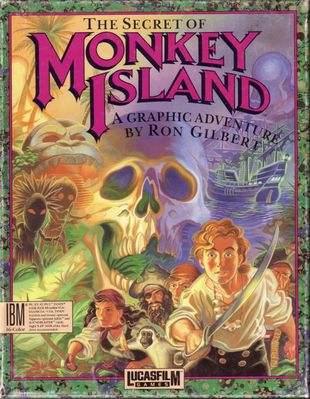
Beyond its historical relevance, however, the game is just plain a whole lot of fun: a whacky, whimsical pirate adventure of epic proportions. It makes sense, then, that its atmosphere was based on Disneyland’s Pirates of the Caribbean, Ron Gilbert’s favorite childhood theme park ride. This is the tale of hapless young Guybrush Threepwood, who has no special skills besides being able to hold his breath underwater for ten minutes. Guybrush must complete three trials to become a pirate, but this quest soon gives way to a manic journey through fictional tropical islands in pursuit of love. The problem is, his efforts to woo Elaine Marley, ass-kicking governor and would-be plunder bunny, are met at every turn by the ghost pirate LeChuck, who is so determined to have Elaine for himself that he refuses to even acknowledge his own death. Exploring the gorgeous island settings and solving creative puzzles are a delight using the game’s modified SCUMM interface, and just try to stop yourself swaying to the grooves of Michael Land’s catchy reggae-infused pirate score. Dialogue is given additional attention here, giving you extra time to converse with a hilarious cast of characters and partake in what is arguably the game’s comedic masterstroke: insult swordfighting, since any swashbuckling buccaneer’s taunting wit must be just as sharp as one’s blade.
The Secret of Monkey Island was critically acclaimed and highly popular, and would go on to spawn three sequels at LucasArts, the third game sporting a very different look and adding voice acting for the first time, including the late great Earl Boen as LeChuck, and Dominic Armato, whose distinctive delivery has become forever, indelibly linked to the character of Guybrush. The same actors reprised their roles in the 2009 remake of the original game, along with updated visuals, a remastered musical score, hint system, and a streamlined point-and-click interface. That same year, Telltale Games produced a whole new episodic series adventure, and after a surprise spinoff in the Sea of Thieves universe, Ron Gilbert (with Dave Grossman) surprised everyone with his return to the franchise he created, releasing Return to Monkey Island in 2022. But the ultimate legacy of The Secret of Monkey Island is not in how many units it sold or secrets it uncovered, but in how many funny bones it tickled and legions of adventure game fans it helped fall head over heels for the genre. So lift your mug o’ grog, and all hail The Secret of Monkey Island! Dare to disagree and we have only one thing to say in response: You fight like a cow.
Grim Fandango
In less gifted hands, Tim Schafer’s Day of the Dead-inspired Grim Fandango could have been a mess. You play as a kind of Grim Reaper, but really just one of many Grim Reapers, all part of a sleazy sales operation to ensure that fresh arrivals to the Land of the Dead receive the best travel package possible through the Eighth Underworld to the Land of Eternal Rest – or at least the package they earned through good deeds in their lives marketed as the best. The retro-futuristic 1950s-era plot revolves around inter-office politics and a far-reaching corporate conspiracy, while the supporting cast includes a zany mechanic, a charismatic revolutionary, and a pretentious beat poet, among many others. Stylistically, Grim Fandango marries Aztec religious philosophy with nods to mid-20th century films ranging from film noir to politically charged pictures such as On the Waterfront. The tone frequently but seamlessly shifts between lively humor and grave drama. With so much going on, there’s a lot that could have gone wrong.
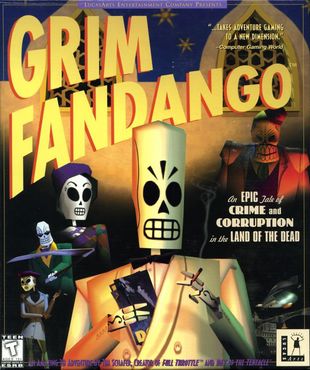
It took the unique vision and brilliant craftsmanship of Tim Schafer and his talented team at LucasArts to blend such a diversity of elements to near-perfection, and in doing so create one of the greatest adventure games – no, greatest video games – of all time. Grim Fandango still ranks among the most boldly executed cinematic experiences gaming can offer, with some of the finest voice acting ever captured, a score by Peter McConnell integrating orchestral film fare with jazz and Mexican folk, and lush art direction that transcended the graphical limitations of the time. In his performance of Manny Calavera, Tony Plana created an adventure game icon replete with personality, humor and pathos. The puzzle-heavy gameplay was both challenging and endlessly engaging, the Casablanca-inspired setting of Rubacava featuring one of the strongest sequences of puzzles ever made, every individual brainteaser smart in concept and practice and unified by a broader set of goals flawlessly integrated with the narrative.
If there’s a “but” in this extraordinary achievement, it’s that Grim Fandango was the first post-Maniac Mansion LucasArts adventure not to use the point-and-click SCUMM interface, forsaking any visible user display (Manny would brilliantly turn his oversized calaca skeleton head to indicate objects of interest) and instead relying on keyboard “tank” controls to maneuver 3D characters overlaid on pre-rendered backgrounds. Perhaps that’s one reason it didn’t initially sell as well as expected, and its relative commercial failure contributed to LucasArts turning way from adventure games altogether soon after. Thankfully for a game about dead people, Grim Fandango showed it still had plenty of life left in it. When Tim Schafer acquired the rights from his former company with Sony’s help, a mouse-driven option was included in the 2014 Remastered Edition, along with improved character graphics, a fully orchestrated score and director’s commentary, improving an already outstanding game and removing that one final hurdle for those uncomfortable with the original controls. Over time, the game’s audacious creative genius finally found its broader intended audience, securing its place even more conclusively as a no-doubt Hall of Fame inductee.
Adventure Game Hall of Fame – Class of 2024 Creators
Ron Gilbert
Ron Gilbert has done as much as, if not more than, anyone else to help shape, evolve, and refine the graphic adventure game genre as we know it today. After teaching himself to code, Ron soon landed with the fledging Lucasfilm Games division doing ports for Commodore 64 titles. Thank goodness they saw enough potential in Ron to give him control over his own game – an adventure about a group of young people venturing into a crazy old scientist’s mansion – because the rest, as they say, is history. Ron wanted to leave behind the text-driven gameplay of that era for a purely point-and-click experience, and so, alongside Gary Winnick, he co-designed the Script Creation Utility for Maniac Mansion, better known by its acronym SCUMM, and added in video interludes that Ron would first call “cutscenes.”
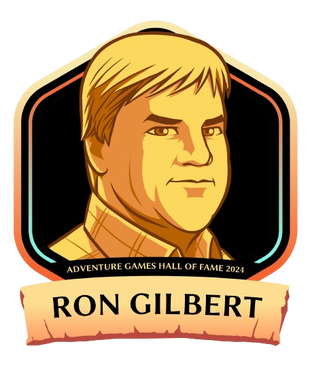
The SCUMM engine would go on to form the basis of many iconic Lucasfilm Games (later LucasArts) classics, including Ron's best known creation, the beloved comedy pirate adventure The Secret of Monkey Island and its sequel, LeChuck’s Revenge, whose popularity helped catapult the company to the pinnacle of the adventure game industry during the genre’s Golden Era in the 1990s. Having achieved his goals so spectacularly, Ron then left to form Humongous Entertainment with fellow LucasArts alumnus Shelley Day, where they went on to create dozens of “junior adventures” starring child favorites Putt-Putt, Freddi Fish, Pajama Sam and Spy Fox, among others.
Ron has achieved success outside the adventure genre as well, co-founding Cavedog Entertainment to launch the real-time strategy title Total Annihilation, as well as dabbling in RPGs as creative director at Hothead Games. But Ron kept returning independently to adventure games over the years with The Cave, Thimbleweed Park, and – surprising us all after thirty-plus-years – the first Ron Gilbert-helmed installment in the franchise he created, Return to Monkey Island. So what does the self-proclaimed “grumpy gamer” have in store for us next? We’re not sure, but if indeed he has more creative tricks up his sleeve, this Hall of Fame legend has certainly earned the right to choose his own time, his own place to make his mark on the genre once again.
Dave Gilbert
If other Hall of Famers could rightly be considered the pioneers of the classic adventure game genre, Dave Gilbert and his company Wadjet Eye Games should be considered a vanguard of the modern adventure game, dominated by passionate independent developers working with limited budgets. During a bleak time for commercial adventure game companies in the early 2000s, Dave was one of the leading indie developers keeping interest in the genre alive through their entertaining freeware offerings, many of them made with the Adventure Game Studio engine, where a community of like-minded creators were able to bond and support each other. Dave’s first game was The Repossessor in 2001, an entry in the Reality-on-the-Norm shared universe series, and went on to produce other highly acclaimed games including Bestowers of Eternity and Two of a Kind, winning numerous freeware game awards in the process.

In order to release The Shivah commercially, Dave founded his own publishing label called Wadjet Eye Games in 2006. From there he proceeded to release The Blackwell Legacy, a substantially overhauled version of Bestowers of Eternity, which has since been followed up by four sequels to form one of the most highly regarded modern adventure game franchises. Dave also created the more casual Emerald City Confidential, set in L. Frank Baum’s land of Oz, before returning to wholly original ideas with this mainstream breakthrough hit Unavowed. An accomplished voice director and amateur actor as well, Dave sensed an opportunity to do more for fellow developers between his personal projects and began helping other studios produce their own games, resulting in some of the most revered indie projects of the last two decades, including Gemini Rue, Resonance, Primordia, Technobabylon, Shardlight, Kathy Rain and many more.
There are no signs of Dave Gilbert slowing down, with another highly anticipated new adventure (Old Skies) in the works, but already Dave has set the standard and inspired countless other indie developers to pursue their passion, and today the adventure genre is thriving thanks in large part to this enduring legacy.
Jane Jensen
Jane Jensen may be best known for one particular character, but she’s created countless others over the course of her storied career. One of the earliest trailblazers for women in gaming, Jane first made a name for herself at Sierra On-Line, contributing to such highly regarded titles as EcoQuest: The Search for Cetus, Police Quest III: The Kindred, Pepper’s Adventures in Time, and most notably King's Quest VI: Heir Today, Gone Tomorrow, alongside Roberta Williams. Then Jane took the reins of her own project for the first time, and the result was 1993’s Gabriel Knight: Sins of the Fathers. Along with its two equally acclaimed sequels, the Gabriel Knight trilogy formed one of the most beloved adventure game series of all time, noted for its thoughtful, meticulously researched stories, immersive gameplay and rich characterization. A prolific book author as well as game designer, Jane also wrote two novelizations of the Gabriel Knight series.
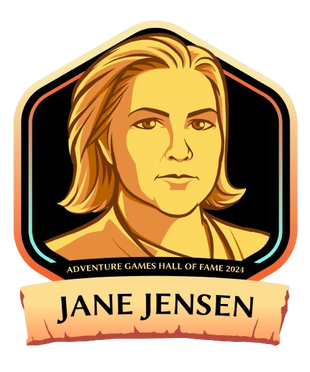
If her career ended there, Jane Jensen would already have a strong case for Hall of Fame induction. But while subsequent efforts may not have quite reached the heights of her iconic creation, Jane went on to develop more popular adventures games post-Sierra, including Gray Matter and Moebius: Empire Rising, the latter with her own studio Pinkerton Road. Less known is that Jane co-founded Oberon Media, whose publishing arm I-play was highly instrumental in bringing adventure games to the casual game market. Franchises such as Agatha Christie and James Patterson’s Women's Murder Club, as well as other successful hidden object adventures like Deadtime Stories and Charlaine Harris: Dying for Daylight, brought Jane's unique brand of storytelling and puzzle-solving to a whole new demographic, creating legions of new adventure game fans in the process.
Along with her husband, composer Robert Holmes, with whom Jane worked on many of her adventure games, Jane has publicly stated that she would gladly return to the genre with a fourth Gabriel Knight installment under the right licensing agreement, so there’s reason for fans to hope that there are more chapters yet to be written in an already Hall of Fame career.
Tim Schafer
Any “best of” list of all-time great adventures is sure to be sprinkled liberally with Tim Schafer’s games. After famously admitting to playing a pirated game in his job interview, then following up with a cover letter in the form of a “semi-graphic adventure,” Tim landed a job at then-Lucasfilm Games as an Assistant Designer/Programmer in 1989. Before long he was contributing to the success of The Secret of Monkey Island and its subsequent sequel as co-writer, but his career really took off as co- or lead writer/designer/director of a string of much-loved, enduring genre classics, namely Day of the Tentacle, Full Throttle, and Grim Fandango.

The latter marked the end of Tim’s career at LucasArts, but only the start of a brand new chapter with his own company, Double Fine Productions. While Double Fine didn’t focus exclusively on adventure games, the company oversaw the remasters of Tim’s acclaimed earlier hits and produced the wonderfully creative nesting doll adventure, Stacking. Tim himself took the lead role in creating the popular Psychonauts action-adventure series, as well as writing the more puzzle-oriented VR spinoff Psychonauts in the Rhombus of Ruin. In 2012, Tim proposed a small “Double Fine Adventure” and companion film documentary on Kickstarter, which blew the doors off the still relatively unheralded crowdfunding service and raised over three million dollars from nearly 90,000 backers, thus paving the way for many other developers to follow in his footsteps with projects of their own. The overwhelming response raised the scope of Tim’s project considerably, ultimately resulting in the ambitious two-part adventure, Broken Age.
Perhaps drawing on his own experience as a young “scummlet” at Lucasfilm Games before being given control of his own projects, Tim has also been a major supporter of Double Fine designers, encouraging innovation though the company’s Amnesia Fortnight prototype competitions, further extending an already impressive legacy of artistic influence on the industry. So what lies ahead for Tm Schafer and Double Fine? For now he’s not saying, but we can be sure of one thing: Any future endeavors will undoubtedly display the same uniquely creative design sensibilities that have been a hallmark of all Tim’s games, featuring memorable stories filled with quirky, offbeat characters and often hilarious dialogue. Whatever awaits, we’ll be first in line, eager to see what this Hall of Fame designer has dreamed up next.
Ken and Roberta Williams
Even on their own, both Ken and Roberta Williams would be sure-fire, first-ballot Hall of Fame inductees. Together they undoubtedly make the most influential power couple the videogame industry has ever seen – Roberta the dynamic creative force and Ken the technology and business expert who combined to establish and popularize the graphic adventure game, then went on to form one of the pre-eminent gaming empires of its day, spanning countless beloved series, including King’s Quest, Space Quest, Leisure Suit Larry, Police Quest, Gabriel Knight, Quest for Glory, Laura Bow and many more.

Ken and Roberta co-founded On-Line Systems in 1979. An ambitious young entrepreneur and coder, Ken intended to write business software for the Apple, but those plans – and the very future of the adventure genre – changed when Roberta was inspired by Will Crowther’s and Don Woods’ Colossal Cave Adventure and wanted to make a game of her own, but with pictures! And just like that, the graphic adventure was born, moving past the purely text-based presentations of games to that point. With that they were on their way with their “Hi-Res Adventure” series of games. Roberta then created the company’s (by then renamed Sierra On-Line) flagship King’s Quest series, further refining the genre by introducing interactive animation, as well as other titles such as Mixed-Up Mother Goose, The Colonel’s Bequest, and Phantasmagoria.
Sierra’s achievements are far too numerous to fully detail, but the company continually innovated and pushed boundaries as industry pioneers in the areas of sound, graphics, mechanics, controls and gameplay. The company was also years ahead of its time in launching The Sierra Network, the first online gaming environment, later renamed the ImagiNation Network. With Roberta focused on her own adventure game properties, Ken oversaw a staff of hundreds as the company grew to a multimillion-dollar enterprise, then endured some wildly turbulent years that shook the entire industry. Through it all, Sierra was determined to maintain a personal connection to fans, in part by launching their own gaming magazine that eventually settled on the familiar name InterAction in 1991.
Following their departure from Sierra, after which the company (and the adventure genre) would never be the same, Ken and Roberta looked to leave the gaming industry behind as they cruised the world’s oceans in their new career as accomplished boaters. But when circumstances caused them to change course, they began to reconnect with their adventure game roots. Ken wrote a memoir called Not All Fairy Tales Have Happy Endings: The Rise and Fall of Sierra On-Line, and together they began work on Colossal Cave, a passion project designed to bring the original text game that inspired Roberta to get into gaming into glorious graphical 3D for the first time. It’s a welcome return to the fold for such distinguished adventure game royalty, and their induction into the Hall of Fame represents just a fraction of our gratitude for all the wonderful memories they’ve given us.
Additional FAQ
How are nominees and winners decided?
A select committee of adventure game media professionals and influencers meet to discuss eligible nominees, culminating in a final list of fifteen people and games each. Winners are then determined by a larger voting pool of genre enthusiasts who have demonstrated their experience, expertise, and commitment to the success of the genre. (Note: No developers in either group are permitted to vote for themselves or their own games.)
What games or creators are eligible for the Adventure Game Hall of Fame?
All of them! With the usual caveat that “adventure game” is a loosely defined term that is open to interpretation. We consider adventures to be thoughtful games of exploration and discovery, with a heavy focus on story and/or puzzles rather than reliance on action or other commonly recognized genre elements.
Note that despite being called the Hall of Fame, “fame” is not a defining criterion for inclusion. This is not a popularity contest but rather a measure of impact on the adventure genre. It’s more of a “lifetime achievement” award that recognizes extraordinary significance, whether in or out of the limelight.
Why are some inductees listed as a couple or team while others are individuals?
In certain cases, even when a strong case can be made for solo induction, the accomplishments of an individual are so intrinsically linked to those of a partnership or larger group that they are best recognized as a whole. (Ken and Roberta Williams, for example, are each eminently qualified as individuals, but their careers are so inseparable that they best merited consideration as a couple.)
Is the Hall of Fame in a physical location?
There is currently no physical location for the Adventure Game Hall of Fame, but a dedicated webpage (in progress) will be continually updated and maintained by Adventure Game Hotspot, displaying all Hall of Fame winners with photos and bios.
When will the next Adventure Game Hall of Fame induction be held?
Stay tuned!


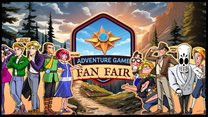


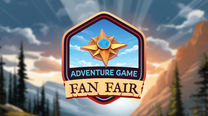

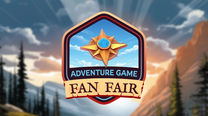


3 Comments
Want to join the discussion? Leave a comment as guest, sign in or register in our forums.
Great read, thank you.
Reply
Great first list of developers and games. I do miss Broken Sword and Charles Cecil in this list. Are those eligable for next inaugurations or will only newer devs/games be considered?
Reply
Hi, Subbi. Actually, most of these are older devs/games and the Hall of Fame will probably always skew that way. (Takes a while to build a HOF-worthy legacy!) But to answer your question specifically, both Charles Cecil and Broken Sword were on our list of final nominees this year, so you can be sure you'll be hearing from them before too long. We did a video of the nominees a while back: https://www.youtube.com/watch?v=EfDFpzlPvGE (which, thanks to your comment, I've now included in the article as well).
Reply
Leave a comment